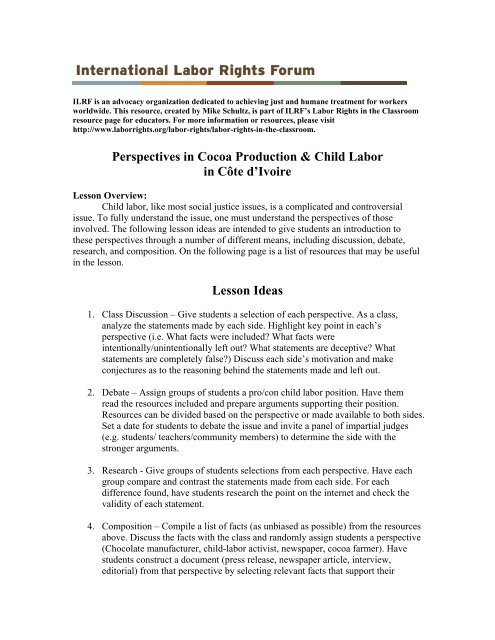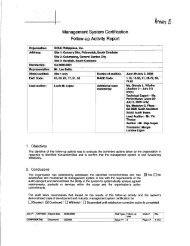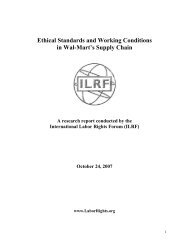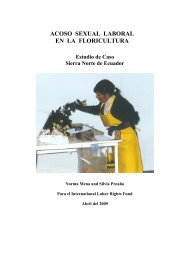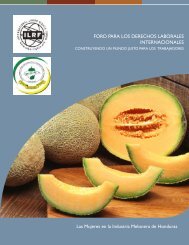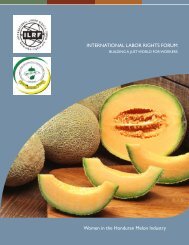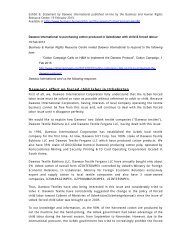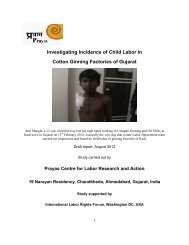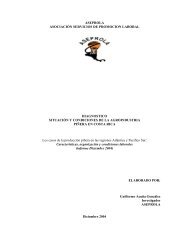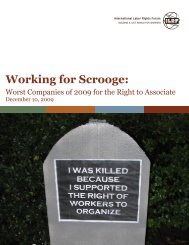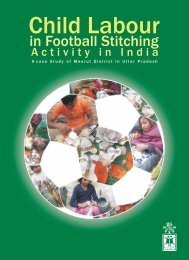Perspectives in Cocoa Production & Child Labor in Côte d'Ivoire ...
Perspectives in Cocoa Production & Child Labor in Côte d'Ivoire ...
Perspectives in Cocoa Production & Child Labor in Côte d'Ivoire ...
Create successful ePaper yourself
Turn your PDF publications into a flip-book with our unique Google optimized e-Paper software.
ILRF is an advocacy organization dedicated to achiev<strong>in</strong>g just and humane treatment for workersworldwide. This resource, created by Mike Schultz, is part of ILRF’s <strong>Labor</strong> Rights <strong>in</strong> the Classroomresource page for educators. For more <strong>in</strong>formation or resources, please visithttp://www.laborrights.org/labor-rights/labor-rights-<strong>in</strong>-the-classroom.<strong>Perspectives</strong> <strong>in</strong> <strong>Cocoa</strong> <strong>Production</strong> & <strong>Child</strong> <strong>Labor</strong><strong>in</strong> Côte d’IvoireLesson Overview:<strong>Child</strong> labor, like most social justice issues, is a complicated and controversialissue. To fully understand the issue, one must understand the perspectives of those<strong>in</strong>volved. The follow<strong>in</strong>g lesson ideas are <strong>in</strong>tended to give students an <strong>in</strong>troduction tothese perspectives through a number of different means, <strong>in</strong>clud<strong>in</strong>g discussion, debate,research, and composition. On the follow<strong>in</strong>g page is a list of resources that may be useful<strong>in</strong> the lesson.Lesson Ideas1. Class Discussion – Give students a selection of each perspective. As a class,analyze the statements made by each side. Highlight key po<strong>in</strong>t <strong>in</strong> each’sperspective (i.e. What facts were <strong>in</strong>cluded? What facts were<strong>in</strong>tentionally/un<strong>in</strong>tentionally left out? What statements are deceptive? Whatstatements are completely false?) Discuss each side’s motivation and makeconjectures as to the reason<strong>in</strong>g beh<strong>in</strong>d the statements made and left out.2. Debate – Assign groups of students a pro/con child labor position. Have themread the resources <strong>in</strong>cluded and prepare arguments support<strong>in</strong>g their position.Resources can be divided based on the perspective or made available to both sides.Set a date for students to debate the issue and <strong>in</strong>vite a panel of impartial judges(e.g. students/ teachers/community members) to determ<strong>in</strong>e the side with thestronger arguments.3. Research - Give groups of students selections from each perspective. Have eachgroup compare and contrast the statements made from each side. For eachdifference found, have students research the po<strong>in</strong>t on the <strong>in</strong>ternet and check thevalidity of each statement.4. Composition – Compile a list of facts (as unbiased as possible) from the resourcesabove. Discuss the facts with the class and randomly assign students a perspective(Chocolate manufacturer, child-labor activist, newspaper, cocoa farmer). Havestudents construct a document (press release, newspaper article, <strong>in</strong>terview,editorial) from that perspective by select<strong>in</strong>g relevant facts that support their
position. Compare f<strong>in</strong>ished perspective papers with actual documents from thatperspective.Perspective ResourcesNewspaper / Press / General:• List<strong>in</strong>g of news & paper related to child labor <strong>in</strong> cocoa <strong>in</strong>dustryhttp://www.laborrights.org/press/<strong>in</strong>dex.html#cocoa• US Department of <strong>Labor</strong> on child labor <strong>in</strong> Cote D’Ivoirehttp://www.dol.gov/ILAB/media/reports/flt/cote-<strong>d'Ivoire</strong>-2002.htm#d19Corporate <strong>Perspectives</strong>:Press Releases, Statements, Websites• General: http://www.responsiblecocoa.org/• Nestle: http://www.nestle.com/Our_Responsibility/Responsibility.htm• Cargill: http://www.cargill.com/news/issues/cocoa<strong>in</strong>dustry.htmhttp://www.cargill.com/news/<strong>in</strong>dex.htm• ADM: http://www.admworld.com/pdf/ADMStatementEnglish.pdfhttp://www.admworld.com/naen/pressroom/Activist / Local Perspective:• NPR Kojo Nnamdi Show Interview: <strong>Cocoa</strong> and <strong>Child</strong> SlaveryAbstract: It's sweet, sugary...and scandalous? For many Americans, chocolate isconnected to <strong>in</strong>dulgence and pleasure. But human rights advocates say chocolate has adarker side. In West Africa scores of children are forced to harvest the cocoa beans thatmake our chocolate. A look at the issue of forced labor and the chocolate <strong>in</strong>dustry.GuestsLowell Satre, author of "Chocolate on Trial: Slavery, Politics, and the Ethics ofBus<strong>in</strong>ess"Jolene Smith, Executive Director, Free the SlavesNatacha Thys, Associate General Counsel, International <strong>Labor</strong> Rights FundEliot Engel, Congressman, U.S. House of Representatives (D-NY)L<strong>in</strong>k:http://www.wamu.org/programs/kn/05/08/08.phpDirect l<strong>in</strong>k to audio: http://www.wamu.org/audio/kn/05/08/k2050808-7927.asx• ILRF <strong>Child</strong> <strong>Labor</strong> and <strong>Cocoa</strong> CampaignFact sheets, list of press releases, and legal proceed<strong>in</strong>gshttp://www.laborrights.org/stop-child-labor/cocoa-campaign


